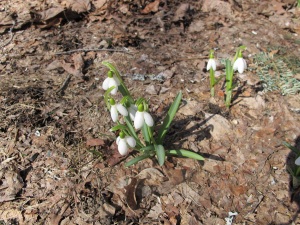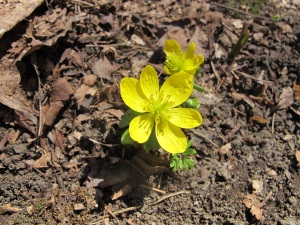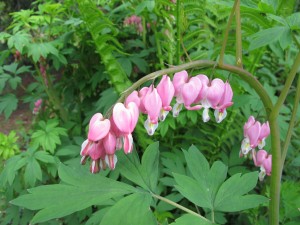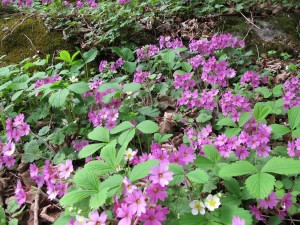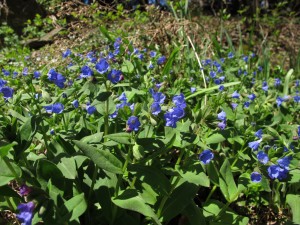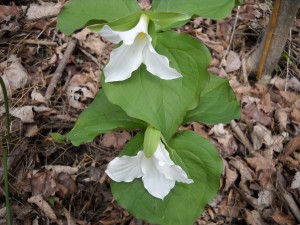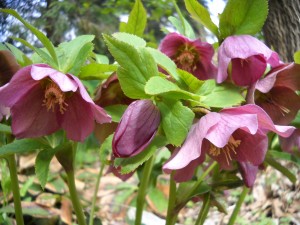Spring Activities
Spring has been slow in showing its colors. Snowdrops, usually up in early March at my house, were a month late. Crocus, the early ones, and winter aconite (a flower that is a nice school bus yellow color) are finally blooming. But everything is slow, and the ground is still frozen a few inches down. I won’t be planting anything outside for weeks.
So what can we do on a warm, sunny day? Maybe we better start by thinking about what NOT to do. Don’t rake the lawn while the soil is still soggy. I recently saw a fellow raking his lawn – even though there was still snow on it in places. Soil structure can be damaged if you compress it and squeeze out all the air spaces in it. This is easily done by walking on it when the soil is still frozen and wet – it’s very fragile. And it’s easy to rip out your grass with a rake if it hasn’t woken up and turned green.
Don’t rototill your vegetable garden early, either. If you are going to rototill, wait until the soil is good and dry. Take a handful of soil and squeeze it into a ball or cylinder. Then, with your other hand, tap it with a finger. It should fall apart. You want the soil crumbly before rototilling, though some clay soils never get to that point. Rototilling sticky wet soil can create heavy clods that roots will not easily penetrate.
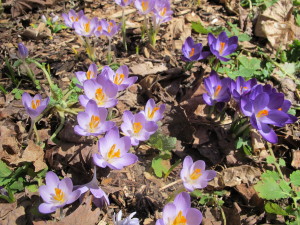
So what can you do now? As soon as the snow disappears you can collect a soil sample and send it off to your state university extension service. Just Google “soil test” and your state, and you will find where to send a sample and how to collect it. I usually sun dry a sample on a cookie sheet, and remove any bits of grass, roots and rocks. As a rule of thumb, it is good to collect your sample from the depth where roots will be. For most things, that is 4 to 6 inches deep.
If you live in a house that was built before 1978, its exterior paint probably has some lead in it. Lead paint has been shown to contaminate soil and to be picked up by plants; this is most severe within 20 feet of the house, or even further if you are on a hill. Testing for heavy metals can be expensive: in New Hampshire the test for it is $65. But if you have small children and will be gardening near the house, it is a worthwhile one-time investment. Children are most severely affected by lead poisoning.
Root crops are the worst offenders when it comes to picking up lead and arsenic, another heavy metal. Lead was an additive to gasoline up until 1996 in most states, and lead from exhaust can still be a problem within 100 feet of a major highway. Arsenic was used as an insecticide, particularly in apple orchards up until the 1980’s, either as lead arsenate or calcium arsenate. Heavy metal compounds like that do not dissipate or disappear easily or quickly.
So how can you improve your soil? In a word, compost. Good compost is biologically active, meaning that it is full of beneficial microorganisms – bacteria and fungi. Later, when my lawn has turned green, I may spread some compost on it to improve the soil. All I do is fling compost over the lawn with a shovel, and then use a lawn rake to even it out.
Half an inch of compost spread out over the lawn will help a lot, particularly if you have used chemicals on the lawn. Fertilizers and particularly “Weed-n-Feed” products inhibit the growth and survival of microbes that will give your lawn that springy feel when you walk on it barefoot this summer. Compost adds organic matter and carbon to feed microbes that can’t use photosynthesis to get their own food. Earthworms love compost, too. Add compost, and they will come and help to get it down into the soil.
I have, carefully, raked leaves off one of my bulb beds. I did so recently. I was delighted to see, beneath a layer of leaves, the tips of daffodils and other bulbs were showing. I didn’t walk into the bed, as that would compact the soil, so I just reached what I could from the edge. That meant the back of the bed stayed unraked for now.
I have been known to lay down boards to walk on to avoid soil compaction at this time of year. Six-inch wide boards cut in five-foot lengths are good: they are light enough to move around, but do a good job of distributing my weight. Two or three is all you need. And once, to avoid compacting the soil, I wore my snowshoes. The neighbors probably thought I was crazy!
This is a good time of year to do a little maintenance on your tools. Take a big, rough file and sharpen the edges of your shovels and hoes. Just try to mimic the angle that exists already. A sharp tool works so much better than a dull one.
I apply boiled linseed oil once a year to keep wooden handles from drying out. I paint it on, let it soak in, and then rub the handles with a rag to polish them up. The handle on my potato hoe, which I got from my family’s garage 30 years ago, is probably 50 years old – but still smooth, strong and splinter-free because I take good care of it.
So don’t rush into spring. Enjoy a warm lazy day from the deck and know that soon the soil will be dry enough to start raking.
Henry Homeyer has a new book: The New Hampshire Gardener’s Companion, Second Edition. This edition has 2 new chapters and updated information in all chapters. His e-mail is henry.homeyer@comcast.net.
Spring Flowers
Like most gardeners, I rejoice in spring. New leaves on trees have a special hue; the grass is finally green; flowers of every persuasion are in bloom. The air is warm, the black flies haven’t arrived, life is good. So we trundle off to the garden center and buy flowers and plant them. Here are some flowers I am enjoying in May, including a few you might not have in your garden.
I know most of you don’t like Latin names of flowers, but they are useful for precisely naming flowers, and for showing relationships. The scientific genus Dicentra is in its full glory now: D. spectabalis, D. exemia, D. cucularia are three species in bloom for me.
The first one (D. spectabalis ) is spectacular, as its Latin name indicates. I have some plants that stand up to 3 feet tall and wide, and it can have dozens of flower stems at once. You probably call it bleeding heart – though some call it “a living Valentine”, which is appropriate since the strands of pink flowers are shaped like cut-out hearts with little appendages hanging down, perhaps drops of blood from a broken heart. It also comes in a pure white variety, a sub-species with the epithet ‘alba’ appended to its name.
Bleeding hearts will grow in full sun, but do better in part sun or dappled shade and rich, lightly moist soil. Full afternoon sun will make them run through the bloom cycle more quickly and the foliage to turn yellow well before autumn.
Fringed bleeding heart (D. exemia) is shorter and less showy. It is a shade plant that will bloom on and off all summer, which is unusual for a perennial. The flowers come in shades of pink to reddish, and there is also a white variety. Although it is often called wild bleeding heart, I have only seen it in the woods a few times. Its foliage is very nice – it is highly incised and frilly.
The last of the three, D. cucularia, is commonly known as Dutchman’s breeches for the white flowers which resemble pants hanging on a clothesline. It is a true wildflower, but is sold at a few good nurseries. It is what is called a spring ephemeral: it comes up, blooms, and the foliage disappears after a few weeks. I pronounce its species name cuckoo-laria, which to me is a humorous name for a flower. “Cuckoo, cuckoo” I call out to it when I see it blooming. (See, aren’t you liking Latin better? It can be fun to use.) Mine grows in the shade of an old apple tree in damp, rich black soil.
If you have a mature apple tree, it is a great place for growing primroses. In mid-May I have several species growing under mine, including a fabulous magenta-colored one that has no common name, so you will have to ask for it by its Latin name, Primula kisoana. Or you can call it the kissing primrose, I suppose, since the species name starts off with “kiss”. (Kiss-o-ana). But at the garden center they will not know it by that name, only the Latin. I got mine at Cider Hill Gardens in Windsor, VT.
Primroses are low plants that grow in clumps that I have in all colors except blue. Most do best in shade or part shade, and many will grow in dry shade – though moist soil is better for most. Coming along soon I will have the candelabra primroses (Primula japonica), which indicates they were introduced from Japan). These are the tallest of my primroses, reaching up to 18 inches or so. They have three tiers of blossoms sticking out off a tall straight stem sort of like the spokes of a wagon wheel, and come in at least 3 colors – white, pink, deep red.
For the past 6 weeks or more I’ve had various colors of lungwort (Pulmonaria longifolia) blooming. Lungwort is a dreadful name for a lovely flower, so I call it by its Latin genus, Pulmonaria (pronounced Pull-mon-aria) . It starts very early and blooms for a long time; it comes in a variety of colors: blue, peach, pink and combinations of those. It spreads by root, filling in dark, shady places that many flowers would eschew. It does fine in crummy dry soil.
You know the common bulb plants: daffodils, tulips, crocus. If you’ve planned well – selecting early, mid- and late-season varieties – you have examples of those blooming much of the spring. But do you have summer (or giant) snowflake (Leucojum aestivum)? It is wonderful! I’ve had a clump for 15 years or more, and it just gets bigger and better every year. It reminds me of snowdrops on steroids. White nodding blossoms on tall green stems and lots of foliage. Mine are 18-24 inches tall, even though my reference text on bulbs (Taylor’s Guide to Bulbs) says it should be only 9-12 inches tall.
One last thought: take pictures of your flowers on a weekly basis. These will help you do planning next winter when you are trying to see what times of the year need more color. Your digital camera will keep track of the dates of blooming, too.
Henry Homeyer is a garden designer and public speaker on gardening. Contact him at henry.homeyer@comcast.net, PO Box 364 , Cornish Flat, NH 03746 or 603-543-1307.
Spring Flowers
I love spring. Winter is relatively austere time in the garden so I relish the bounty of spring all the more. Over the years I have tried growing most flowers that will provide color in March, April and May. Below are some of my favorites.
First to bloom are the bulb flowers that begin the spring show in March. I have thousands of snowdrops (Galanathus elwesii), squill (Scilla siberica), glory of the snow (Chionodoxa luciliae). These are followed in April by crocus, daffodils and early tulips. I cut even the smallest blossoms to bring inside and place on the kitchen counter in a vase. Almost all the bulb plants are good cut flowers. I plant bulb plants every fall, and recommend top-dressing them with organic fertilizer after they finish blooming each spring.
Then come the early perennials, starting in April and continuing on into May. One of the first, and easiest to grow, is called lungwort. The unattractive name comes from the leaves, which some unfortunate person decided looked like lungs – complete with spots on most varieties. I prefer to call them by their Latin genus, Pulmonaria, which is more melodious.
Pulmonaria will grow in sun or shade, wet or dry. They spread by root, creating large low-growing colonies. I once had a gardening client who considered them invasive, though I do not. If they overstep their welcome, I find they pull fairly easily with my favorite weeding tool, the CobraHead weeder, which gets under them easily. The small flowers come in shades of blue, pink, peach and white. They don’t do well in a vase, so I don’t pick them.
Another spring favorite of mine is the hellebore, sometimes called the Lenten Rose. Hellebores are among the earliest to send up shoots of flowers and hold those flowers for several weeks. Each flower stalk stands 12 to 15 inches tall and supports new leaves and bell-shaped flowers that are rose to purple in color, or sometimes green and white. Like the Pulmonaria, they do not last well in a vase.
Primroses bloom early, and come in a wide range of species and colors. I have at least 6 different species in bloom now. One of my favorites has no common name, only going by its scientific name, Primula kisoana. Because its species name starts with “kis”, you can call it the kissing primrose – even if no one else does (except me). It has bright magenta-colored flowers that stand just a few inches above the light-green leaves. It is not very well known at nurseries; I found mine at Cider Hill Gardens in Windsor, VT (www.ciderhillgardens.com).
An endearing quality of Primula kisoana is that it spreads by root – but never runs over another plant to establish new territory. Primroses, in general, are form clumps but spread by seed. Some, like the candelabra primrose (Primula japonica) spread very vigorously by seed if the conditions are right for it. That one stands up over two-feet tall, but blooms much later, usually in June. But P. kisoana spreads fast if the soil conditions are right. One plant can grow to cover 1 to 2 square feet in a season. They like rich, dark soil with a slightly acidic pH.
 Most primroses grow well in light shade or morning sunshine and prefer moist soil. Primula kisoana, on the other hand, will grow in dry soil, too. I have observed that one of the best places to grow any primrose is under an old apple tree. The soil and light there generally is perfect for primroses.
Most primroses grow well in light shade or morning sunshine and prefer moist soil. Primula kisoana, on the other hand, will grow in dry soil, too. I have observed that one of the best places to grow any primrose is under an old apple tree. The soil and light there generally is perfect for primroses.
Although it is contrary to the law to dig up wildflowers and transplant them to your property, many good garden centers are now propagating and selling them. In nature, most spring wildflowers grow in the dappled shade of a hardwood forest. They send up flowers and leaves before the trees have leafed out, and disappear soon after the forest becomes shady. Among my favorites are the trilliums, bloodroot, and hepaticas – though there are dozens of other species.
Bloodroot are so named for the red juice that oozes from the roots if cut. I’ve read that Indians used it for dye. The leaves come up wrapped like a cigar around the flower stalk. Each simple white flower stands 6 inches tall. The blossoms open on warm, sunny days and close up at night or on chilly days. They spread by root to form nice clumps. I also have some double bloodroot – the flowers resemble small white double peonies. The flowers are probably sterile, as they keep on blooming much longer than the singles. Most flowers stop blooming once fertilized, having done their work.
I have three species of trillium: the ordinary maroon one (Trillium erectum), the white one (Trillium grandiflorum) and the yellow one (Trillium luteum). All will grow in light shade or part sun and prefer rich, dark soil. The New England Wildflower Society (www.newfs.org) sells all three – and many other fine wildflowers at their headquarters, The Garden in the Woods in Framingham, MA. I bought my yellow trillium from them. In addition to its flower, it has handsome mottled leaves.
So visit your local garden center soon to see what early spring bloomers they offer, and try something new. You’ll be glad you did.
Henry Homeyer is a gardening consultant and the author of 4 gardening books. His Web site is www.Gardening-Guy.com.



